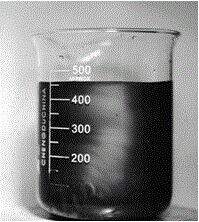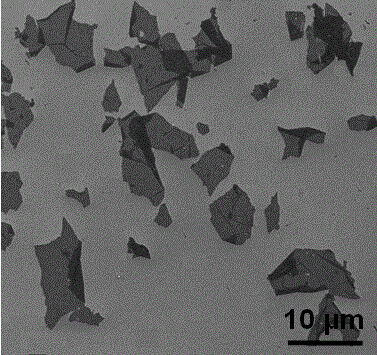A pollution-free and low-cost process for preparing single-layer graphene oxide
A low-cost, non-polluting technology, applied in the field of nanomaterials, can solve problems such as high cost, achieve the effect of less time-consuming and energy-consuming, lowering preparation cost, and no pollution
- Summary
- Abstract
- Description
- Claims
- Application Information
AI Technical Summary
Problems solved by technology
Method used
Image
Examples
Embodiment 1
[0026] Put graphite and strong acid at 0 o Stir, mix and infiltrate at C for 5 minutes, add a strong oxidant, and continue to stir for 1 hour to oxidize and peel off the graphite sheet; centrifuge, recover the supernatant as a strong acid for the next reaction, and slowly pour the muddy product into deionized water to dilute , stirred, washed with 1mol / L dilute hydrochloric acid and then repeatedly cleaned and centrifuged with deionized water to obtain a single-layer graphene oxide aqueous solution; in the waste water generated in step 2), feed ammonia gas to a pH value of 7 to obtain a solution containing nitrogen, An inorganic fertilizer of potassium and iron elements; the graphene oxide aqueous solution obtained in step 2) is concentrated and subjected to freeze-drying / spray drying / supercritical drying technology to obtain graphene powder with high density and high specific surface area. The volume-to-mass ratio of the strong acid to graphite is: 40ml:1g. The mass ratio of...
Embodiment 2
[0028] Combine graphite and strong acid at 40 o Stir, mix and infiltrate at C for 30 minutes, add a strong oxidant, and continue stirring for 8 hours to oxidize and peel off the graphite sheet; centrifuge, recover the supernatant as a strong acid for the next reaction, and slowly pour the muddy product into deionized water to dilute , stirred, washed with 1mol / L dilute hydrochloric acid and then repeatedly cleaned and centrifuged with deionized water to obtain a single-layer graphene oxide aqueous solution; in the waste water generated in step 2), feed ammonia gas to a pH value of 7 to obtain a solution containing nitrogen, An inorganic fertilizer of potassium and iron elements; the graphene oxide aqueous solution obtained in step 2) is concentrated and subjected to freeze-drying / spray drying / supercritical drying technology to obtain graphene powder with high density and high specific surface area. The volume-to-mass ratio of the strong acid to graphite is: 100ml: 1g. The mas...
Embodiment 3
[0030] Graphite with a particle size of 0.5 μm and concentrated sulfuric acid were stirred, mixed and infiltrated at 0°C for 0.5 h, and potassium ferrate and potassium persulfate were added. Then the reaction solution was raised to room temperature for 1 h. After the reaction, the reaction solution was centrifuged to recover the strong acid. Slowly pour the bottom sediment into iced deionized water for dilution, let it stand for a period of time, wash the sediment repeatedly with 1mol / L dilute hydrochloric acid and deionized water, and centrifuge to obtain single-layer graphene oxide. The generated waste liquid is treated with ammonia gas until the pH value is 7 to obtain an inorganic fertilizer containing nitrogen, potassium and iron elements. During the reaction, the ratio of strong acid to graphite is 40ml:1g, and the ratio of potassium ferrate to graphite is 4g:1g. The prepared graphene oxide solution was spray-dried to prepare a khaki graphene oxide powder with a densit...
PUM
| Property | Measurement | Unit |
|---|---|---|
| particle size | aaaaa | aaaaa |
| thickness | aaaaa | aaaaa |
Abstract
Description
Claims
Application Information
 Login to View More
Login to View More - R&D
- Intellectual Property
- Life Sciences
- Materials
- Tech Scout
- Unparalleled Data Quality
- Higher Quality Content
- 60% Fewer Hallucinations
Browse by: Latest US Patents, China's latest patents, Technical Efficacy Thesaurus, Application Domain, Technology Topic, Popular Technical Reports.
© 2025 PatSnap. All rights reserved.Legal|Privacy policy|Modern Slavery Act Transparency Statement|Sitemap|About US| Contact US: help@patsnap.com



